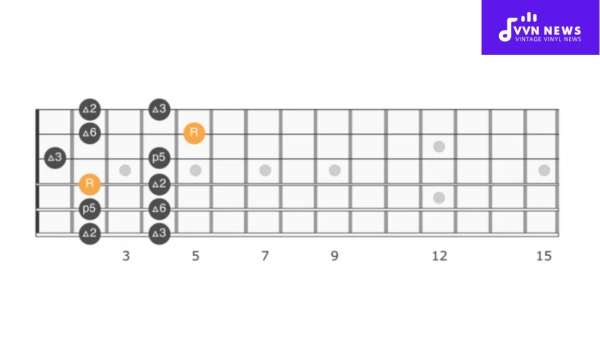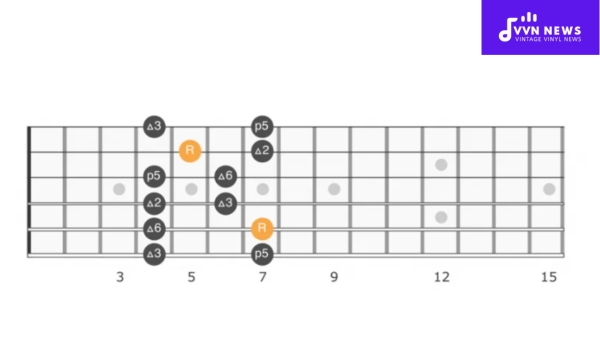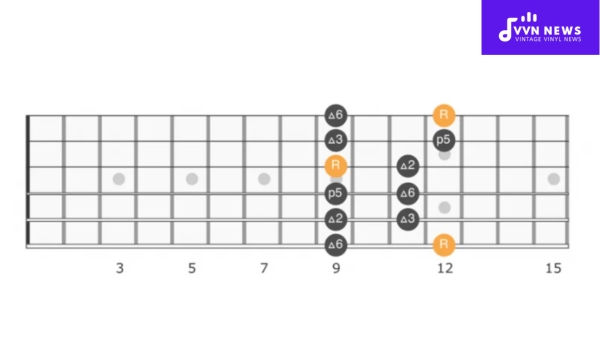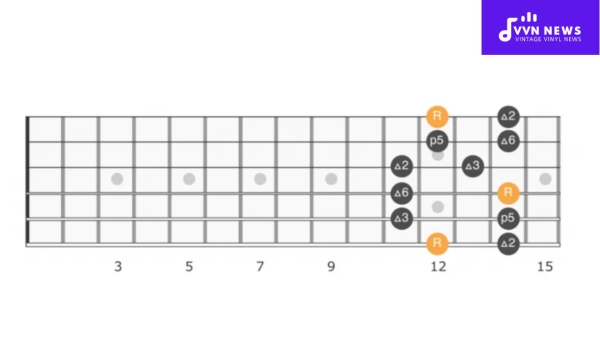To the uninitiated, music theory may sound complex and intimidating. I assure you, that mastering scales and keys like the E major pentatonic scale can prove transformative for your music journey.
By learning scales, you acquire a roadmap to navigate through notes with confidence and enhance your creative skills, be it for composing melodies or improvising solos.
Within the vast landscape of musical scales, some are essential keystones worth your attention.
The E major pentatonic scale is one of such quintessential tools that extends a rich palette of musical possibilities for musicians across all genres.
This scale’s alluring tonal quality has made it a mainstay in countless memorable tunes that have resonated through the decades.
What Constitutes the E Major Pentatonic Scale?
The E Major Pentatonic scale features five, rather than seven, distinct pitches spanning an octave.
These are E – F# – G# – B – C# (in ascending order of the scale). It removes the 4th and 7th degrees found in a standard major scale, leaving it devoid of any half-step intervals.
The resulting sequence sounds consonant or harmonious to our ears. Interestingly, it shares the same notes as its relative minor pentatonic scale, C# minor.
Recognizing this unique composition enables you to integrate this melodious scale into your musical repertoire seamlessly.
How is the E Major Pentatonic Scale formed?
The E Major Pentatonic Scale emerges from its parent, the E Major scale.

To create it, we specifically select five notes that yield a unique tonal character, a process likened to extracting the essence of a full palette.
Imagine you’re choosing the brightest colors for a vivid painting.
This scale is sculpted by taking the first, second, third, fifth, and sixth degrees of the E Major scale—effectively skipping over the fourth and seventh intervals.
It results in this sequence: E, F#, G#, B, and C#. These pitches harmonize seamlessly, providing an inherently pleasant sound due to their lack of half-step dissonance.
The beauty lies in its simplicity; there are no sharp or flat alterations needed beyond what’s already in the key signature of E Major.
This distilled configuration facilitates improvisation and composition without clashing notes.
Moreover, players can swiftly grasp the patterns on their instruments and commence exploring their musical potential.
Also Read: D Sharp Major Pentatonic Scale [A Bright And Positive Tone]
What are the five configurations of the E Major Pentatonic Scale?
The E Major Pentatonic Scale features a unique set of five configurations, often known as ‘shapes’.
Each shape starts from a different note within the scale and spans an octave, and together they cover the entire fretboard of your guitar.
This assists in expanding your capacity to play melodic lines across the fretboard instead of being confined to a single area.
Shape 1: The Root Position
The foremost shape commences from the root note of the scale – E.
Starting on this note, you’d progress through each tone in ascending order: E, F#, G#, B, C#, and back to E again.
This simple sequence offers an excellent foundation for creating spontaneous solos and improvising with other musicians.
Shape 2: The Second Position
A shift up two frets brings us to our second shape starting on F#.
Progressing through we find our notes are now F#, G#, B, C#, and back to E again (now on another string).
This configuration benefits in the knowledge of transitioning smoothly between shapes while playing.
Shape 3: The Third Position
As you move further up the neck into the third position, you start this shape on G#. Our notes will be G#, B, C#, E, and ending with F# (again shifted onto another string).
I assure you that practice with such incremental shifts can drastically enhance your melodic fluency.
Shape 4: The Fourth Position
Onward we shift another two frets higher to introduce the fourth position starting from B.
Spanning through this octave we cover B, C#, E, F# then return to G#.
Versatility with these positions can significantly broaden your music horizons allowing more expressive melodies.
Shape 5: The Fifth position
The last configuration begins two more steps further on C#. Completing this sequence, we run through the notes C#, E, F#, and G#, with a return to B.
This last shape will extend your proficiency in creating advanced solos.
Every note of the E Major Pentatonic Scale still holds its place in each of these configurations; only the starting positions vary.
Recognizing how these shapes interlock and overlap on the fretboard will help you navigate it with greater confidence and fluidity.
Each shape allows you to transition from one position on your instrument (a guitar, for instance) to another effortlessly while maintaining your melodic line.
These are not confined to a single genre; you can employ them irrespective of whether your style leans more towards blues, rock, pop, or jazz.
Also Read: D Major Pentatonic Scale [Learn Its Uplifting Melodies]
How are Relative Major and Minor Pentatonic Scales Similar?
The relationship between relative major and minor pentatonic scales is fascinating—sharing the same key signatures is their most striking feature.

For musicians, this commonality is a thematic bridge that enables seamless transitions within compositions while maintaining tonal cohesion.
Let’s explore the E major pentatonic scale and its relative minor—C# minor pentatonic.
Both scales consist of five notes; in the case of E major, these notes are E, F#, G#, B, and C#.
When you start this sequence from its sixth note, C#, you enter into the relative minor scale: C# minor pentatonic hence includes C#, E, F#, G#, and B.
This kinship implies that both scales weave together over the same fretboard patterns on a guitar or keys on a piano.
As a musician, this parallel allows you to evoke different moods without relearning entirely new scale shapes—optimizing your practice and performance versatility.
By leveraging this intrinsic connection, your improvisational skills can flourish significantly.
Engaging with well-selected backing tracks in either E major or C# minor offers an avenue to experiment with the ambient shifts between joyous major tones and the introspective hues of minor melodies.
Why Use Backing Tracks for E Major Pentatonic Scale Practice?
Practicing the E Major Pentatonic Scale with backing tracks can greatly enhance your musicality and playing technique.
Here are five key reasons to incorporate them into your practice routine:
Boost Your Timing and Rhythm
Playing along with a backing track forces you to maintain a steady pace, aligning your timing with the pre-recorded groove.
Rhythmic precision is crucial in music, and having the aural cue of drums and bass on a track keeps your playing tight and synchronized.
Develop Musical Context
Understanding how the E Major Pentatonic fits within different chord progressions is essential.
Backing tracks provide harmonic context, making it clear how your scale choices complement the underlying chords. This awareness is vital in preparing you for real-world playing situations.
Hone Your Improvisation Skills
Practicing scales in isolation can only take your improvisation so far. A backing track acts as an improvisational canvas, allowing you to experiment with phrasing, dynamics, and melodic ideas in a more lively setting as if you’re jamming with other musicians.
Cultivate Ear Training
Working with backing tracks sharpens your listening skills. Detecting chord changes and identifying intervals within the progression becomes second nature as you match scale notes to different chords within the track, improving your overall musical ear.
Motivation Through Enjoyment
Incorporating backing tracks adds an enjoyable dimension to scale practice, invigorating tedious sessions.
You’re likely to invest more time honing skills when it feels less like work and more like play.
In summary, practicing scales needn’t be monotonous or solitary. Using E Major Pentatonic backing tracks propels forward momentum in multiple areas of musicianship; from enhancing rhythmic stability to fostering improvisational creativity—practice becomes an engaging endeavor rather than just a routine exercise.
Also Read: F Sharp Minor Scale [Discover Its Heartfelt Musical Qualities]
Songs Utilizing the E Major Pentatonic Scale
The E Major Pentatonic Scale, often seen as the gateway to fluid improvisation and melodic construction, has been the backbone of numerous iconic songs.

Its five-note simplicity offers a warm, melodious tone that resonates across a multitude of genres.
Here, I highlight five tracks that have expertly harnessed this scale, creating unforgettable tunes that continue to inspire musicians worldwide.
“Cigarettes and Coffee” by Otis Redding
Otis Redding’s soulful masterpiece “Cigarettes and Coffee” is a testament to the emotive potential of the E Major Pentatonic Scale.
The guitar’s gentle embellishments throughout this track give each verse a tender depth—a perfect companion to Redding’s raw vocal delivery.
“My Girl” by The Temptations
Embodying the Motown sound, “My Girl” by The Temptations is an exquisite example of the E Major Pentatonic in action.
The signature bassline—a mellow counterpart to the vocal melody—utilizes this scale’s open strings and fretted notes, crafting a line that anchors the song in an aura of warmth and nostalgia.
“Sweet Home Alabama” by Lynyrd Skynyrd
An anthem in Southern rock, Lynyrd Skynyrd’s “Sweet Home Alabama” features guitar solos ripe with pentatonic runs.
While not exclusively in E major, these solos dance through different positions of the scale with ease, demonstrating their versatility across keys.
“Take It Easy” by Eagles
Boasting one of rock’s most recognizable openings, “Take It Easy” performed by Eagles efficiently deploys the E Major Pentatonic during solos and interludes.
Here you’ll find quintessential licks that take full advantage of this scale’s accessible yet expressive nature.
“Before You Accuse Me” (Cover) by Eric Clapton
Eric Clapton’s rendition of “Before You Accuse Me” is steeped in bluesy roots where Pentatonics reign supreme.
His guitar work often highlights extended phrases derived from both minor and major pentatonic shapes—showcasing seamless transitions between emotional states.
In these songs, we witness varied applications of E major pentatonic, from foundational rhythms to blistering solos—it transcends roles as both star and support cast with ease.
Explore their melodies and riffs; feel each song’s distinct vibe generated through familiar pentatonic patterns—one could be just the spark needed for your next musical brainstorm.
Also Read: G Minor Scale [Guide To Understanding This Melancholic Tune]
FAQs About The E Major Pentatonic Scale
What is the E Major Pentatonic Scale?
The E major pentatonic scale is a five-note musical scale consisting of the notes E, F#, G#, B, and C#.
How do I play the E Major Pentatonic Scale on guitar?
To play the E Major Pentatonic Scale on guitar, start at the open E string and follow this pattern: open, 2nd fret, 4th fret, open A string, 2nd fret A string. Repeat similar patterns across other strings.
Is the E Major Pentatonic Scale suitable for beginners?
Absolutely! The simplicity of the scale makes it perfect for beginners to quickly begin improvising and creating melodies.
Can you use the E Major Pentatonic Scale over chord progressions in other keys?
Yes, you can use it over chord progressions in closely related keys by finding common tones or as a contrast for a ‘solo’ effect.
What are some benefits of learning pentatonic scales?
Pentatonic scales like the E major version simplify improvisation, help with ear training, and establish a foundation for exploring more complex scales.
Conclusion
In wrapping up our expedition through the enchanting realms of the E Major Pentatonic Scale, it’s evident how this scale enriches musical expression.
Embodying simplicity and versatility, it’s a powerful tool for seasoned maestros and budding enthusiasts alike.
Coupled with the brilliance of your unique creativity, it unlocks melodic doors in every genre imaginable.
Soon, you’ll weave soundscapes that resonate profoundly with every listener’s soul.








